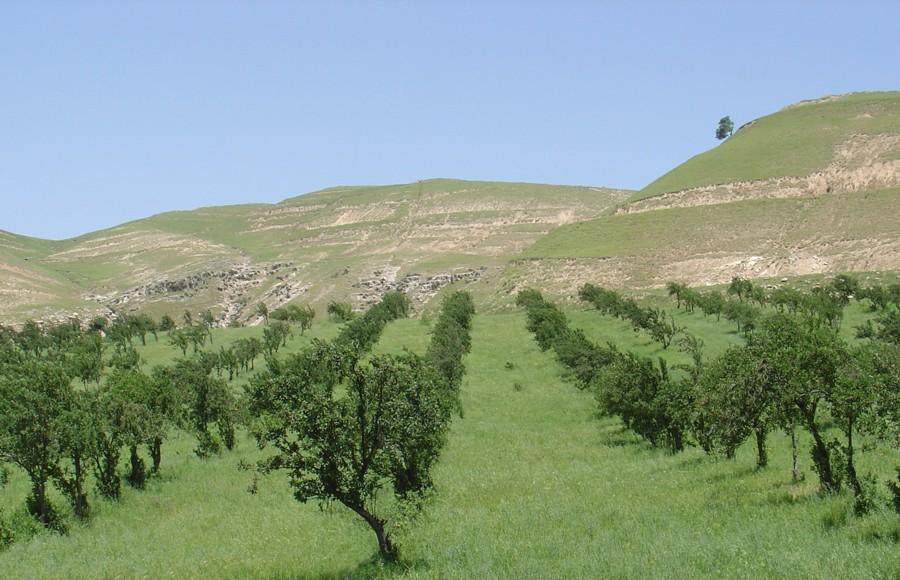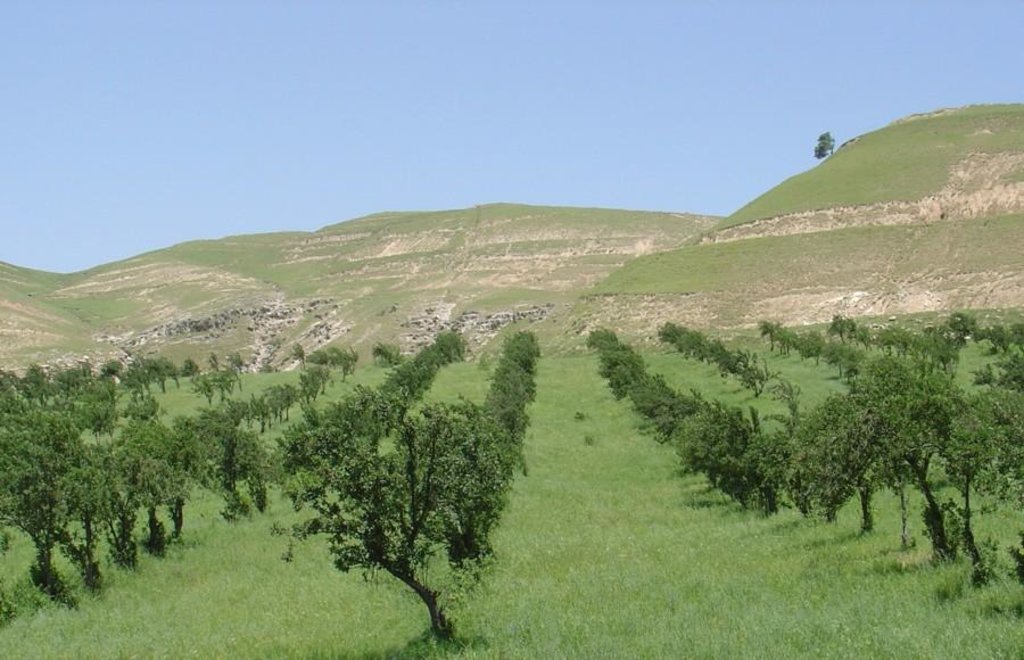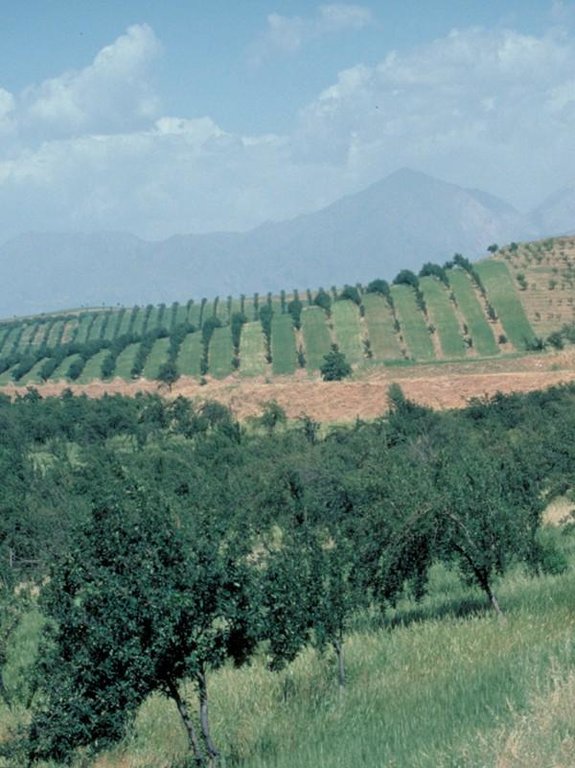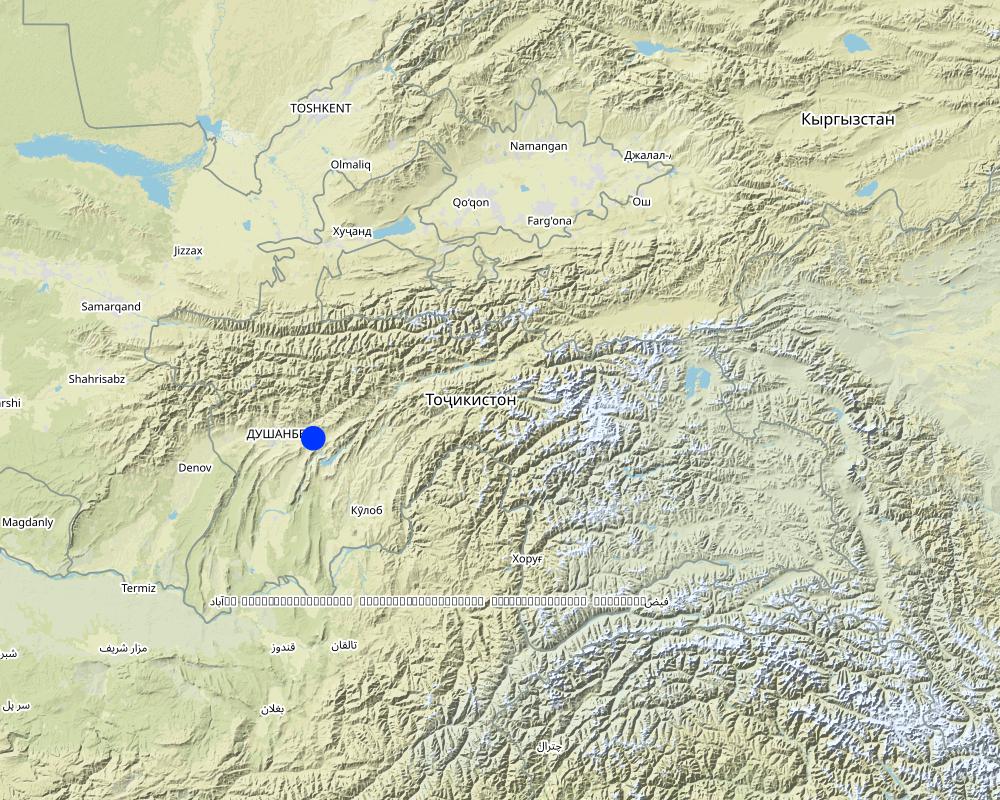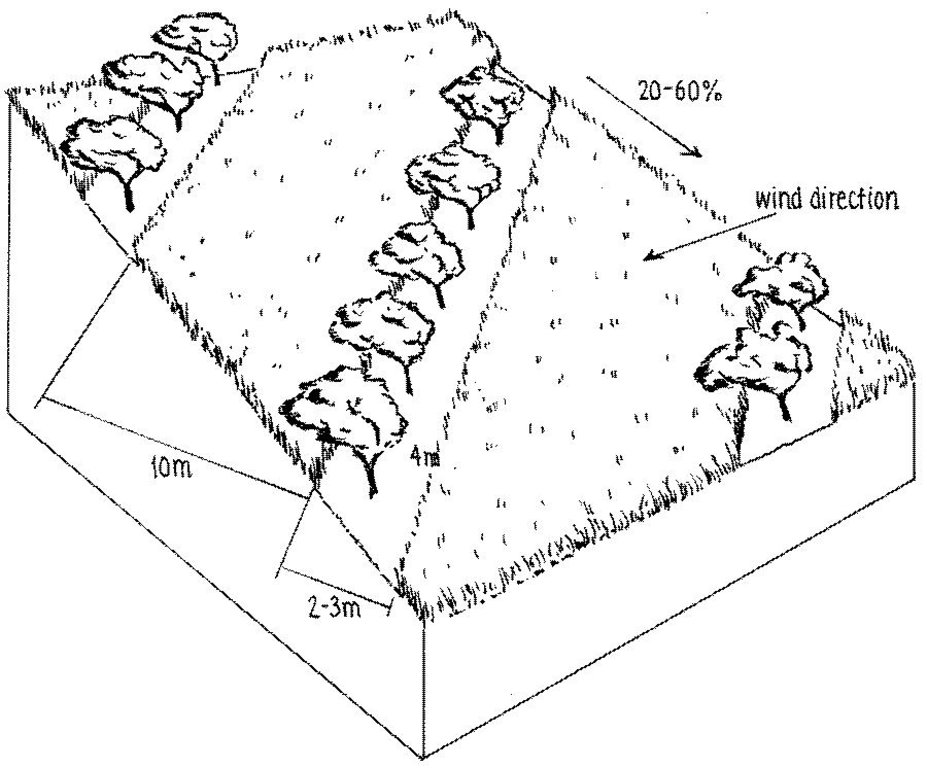Orchard-based agroforestry [Tadjikistan]
- Création :
- Mise à jour :
- Compilateur : Loes Masselink
- Rédacteur : –
- Examinateurs : Deborah Niggli, Alexandra Gavilano, David Streiff, Lisa Soloveva, Olga Andreeva, Laura Ebneter, Joana Eichenberger
technologies_1017 - Tadjikistan
- Résumé complet en PDF
- Résumé complet en PDF pour impression
- Résumé complet dans le navigateur
- Résumé complet (non formaté)
- Orchard-based agroforestry: 14 août 2019 (inactive)
- Orchard-based agroforestry: 2 novembre 2021 (public)
- Orchard-based agroforestry: 4 avril 2018 (inactive)
- Orchard-based agroforestry: 19 juillet 2017 (inactive)
- Orchard-based agroforestry: 17 juillet 2017 (inactive)
- Orchard-based agroforestry: 17 juillet 2017 (inactive)
- Orchard-based agroforestry: 17 juillet 2017 (inactive)
- Orchard-based agroforestry: 9 mars 2017 (inactive)
Voir les sections
Développer tout Réduire tout1. Informations générales
1.2 Coordonnées des personnes-ressources et des institutions impliquées dans l'évaluation et la documentation de la Technologie
Spécialiste GDT:
Nom du projet qui a facilité la documentation/ l'évaluation de la Technologie (si pertinent)
Book project: where the land is greener - Case Studies and Analysis of Soil and Water Conservation Initiatives Worldwide (where the land is greener)Nom du projet qui a facilité la documentation/ l'évaluation de la Technologie (si pertinent)
Pilot Program for Climate Resilience, Tajikistan (WB / PPCR)Nom du ou des institutions qui ont facilité la documentation/ l'évaluation de la Technologie (si pertinent)
CDE Centre for Development and Environment (CDE Centre for Development and Environment) - SuisseNom du ou des institutions qui ont facilité la documentation/ l'évaluation de la Technologie (si pertinent)
Soil Science Institute (Soil Science Institute) - Tadjikistan1.3 Conditions relatives à l'utilisation par WOCAT des données documentées
Le compilateur et la(les) personne(s) ressource(s) acceptent les conditions relatives à l'utilisation par WOCAT des données documentées:
Oui
1.5 Référence au(x) Questionnaires sur les Approches de GDT (documentées au moyen de WOCAT)
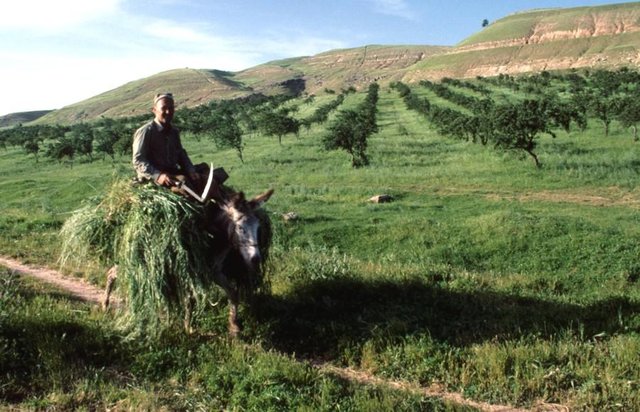
Transition from a centralised regime to a local … [Tadjikistan]
A land use system established during the previous authoritarian regime of the Soviet Union is now being adapted to the farmers' needs via their own initiative.
- Compilateur : Sanginboy Sanginov
2. Description de la Technologie de GDT
2.1 Courte description de la Technologie
Définition de la Technologie:
An agroforestry system where legumes and cereals are planted in fruit orchards, giving simultaneous production and conservation benefits.
2.2 Description détaillée de la Technologie
Description:
In the Faizabad region, Tajikistan, an area which is characterised by hilly topography, and deep but highly erodible loess soils, farmers traditionally cultivate beans and wheat in combination with fruit trees. This was a rather unsystematic agroforestry system, and during Soviet times (in the 1980s) fruit production was intensified. Pure-stand orchards were established: the land was levelled and on slopes exceeding 20%, terraces were constructed mechanically. The density of trees was increased, and the little space remaining between was used for hay production. Annual cropping was stopped.
Purpose of the Technology: After the Soviet era, farmers reduced the number of trees, allowing room for inter-cropping. They also established new orchards according to this same pattern. Those who farm rented land merely inter crop wheat, whereas the few farmers who own their land, rotate crops with two years of wheat, followed by one of legumes (beans or lucern). Crops are grown both for home consumption and sale.
Establishment / maintenance activities and inputs: The density of apples was reduced by expanding the spacing from approx 5 m to 10 m between rows, and from 2 m to 4 m within rows. Along each row of trees a 2-3 m strip of grass was left to grow. The layout of fruit trees in lines is a compromise between being along the contour, and against the prevailing wind. After harvesting of the fruit, between August and October, farmers sow their annual crops.
Natural / human environment: This agroforestry system provides protection against strong winds, heavy rains and flooding. Soil erosion (by water) has been reduced due to improved soil cover by the inter cropping, and through leaf litter, which is left to decompose on the ground. Furthermore, after harvesting, about three quarters of the crop residues are left on the field as mulch. The remainder is used as fodder. Soil organic matter within the current agroforestry system is considerably higher than in the surrounding grazing areas. Soil fertility has improved also: beans can fix 60-80 kg/ha/year of nitrogen. Compared with other crops, wheat provides the best erosion protection. Since the lateral rooting system of the apple trees reaches only 1-1.5 m from the trunk, competition for nutrients is not a major problem. Neither is there a problem with shade, since during the crop establishment period the trees have lose their leaves. In order to increase production, farmers plan to apply supplementary irrigation where possible.
2.3 Photos de la Technologie
2.5 Pays/ région/ lieux où la Technologie a été appliquée et qui sont couverts par cette évaluation
Pays:
Tadjikistan
Région/ Etat/ Province:
Tajikistan, Faizabad
Autres spécifications du lieu:
Faizabad
Commentaires:
Total area covered by the SLM Technology is 45 km2.
Map
×2.6 Date de mise en œuvre de la Technologie
Si l'année précise est inconnue, indiquez la date approximative: :
- il y a entre 10-50 ans
2.7 Introduction de la Technologie
Spécifiez comment la Technologie a été introduite: :
- grâce à l'innovation d'exploitants des terres
3. Classification de la Technologie de GDT
3.1 Principal(aux) objectif(s) de la Technologie
- réduire, prévenir, restaurer les terres dégradées
3.2 Type(s) actuel(s) d'utilisation des terres, là où la Technologie est appliquée
Les divers types d'utilisation des terres au sein du même unité de terrain: :
Oui
Précisez l'utilisation mixte des terres (cultures/ pâturages/ arbres):
- Agroforesterie

Terres cultivées
- Cultures annuelles
- Plantations d’arbres ou de buissons
Cultures annuelles - Précisez les cultures:
- légumineuses et légumes secs - fèves
- céréales - blé de printemps
- lucerne
Plantations d'arbres et d'arbustes - Précisez les cultures:
- fruits à pépins (pommes, poires, coings, etc.)
Commentaires:
Major land use problems (compiler’s opinion): Most of the rains fall in late autumn and early spring, and the rains coincide with very strong winds. The topsoil is therefore exposed to erosion during this period if left uncovered, and without a windbreak. A particular problem during the soviet period was that the intensive orchard system meant annual food crops were left out of the production system: soil cover was reduced and there was less food.
Type of cropping system and major crops comments: two years of wheat followed by one of legumes (beans or lucerne)
3.4 Approvisionnement en eau
Approvisionnement en eau des terres sur lesquelles est appliquée la Technologie:
- pluvial
3.5 Groupe de GDT auquel appartient la Technologie
- agroforesterie
- brise-vent/ plantations abris
- Amélioration de la couverture végétale/ du sol
3.6 Mesures de GDT constituant la Technologie

pratiques agronomiques
- A2: Matière organique/ fertilité du sol
- A7: Autres

pratiques végétales
- V1: Couverture d’arbres et d’arbustes
- V2: Herbes et plantes herbacées pérennes

structures physiques
- S1: Terrasses
Commentaires:
Main measures: agronomic measures, vegetative measures, structural measures
Type of agronomic measures: mulching, rotations / fallows
Type of vegetative measures: aligned: -against wind
3.7 Principaux types de dégradation des terres traités par la Technologie

érosion hydrique des sols
- Wt: perte de la couche superficielle des sols (couche arable)/ érosion de surface
- Wg: ravinement/ érosion en ravines

érosion éolienne des sols
- Et: perte de la couche superficielle des sols (couche arable)

dégradation chimique des sols
- Cn: baisse de la fertilité des sols et réduction du niveau de matière organique (non causée par l’érosion)
Commentaires:
Main type of degradation addressed: Wt: loss of topsoil / surface erosion, Wg: gully erosion / gullying, Et: loss of topsoil, Cn: fertility decline and reduced organic matter content
Main causes of degradation: other human induced causes (specify) (The suplementary irrigation system could not be maintained after state farms stopped recieving government support. Thus, it became more interesting to increase crop production through intercropping.)
Secondary causes of degradation: governance / institutional (With the transformation of the planned economy to a market economy, for the state farm areas new forms of management had to be found.)
3.8 Prévention, réduction de la dégradation ou réhabilitation des terres dégradées
Spécifiez l'objectif de la Technologie au regard de la dégradation des terres:
- prévenir la dégradation des terres
Commentaires:
Main goals: prevention of land degradation
4. Spécifications techniques, activités, intrants et coûts de mise en œuvre
4.1 Dessin technique de la Technologie
Spécifications techniques (associées au dessin technique):
Fruit trees intercropped with wheat (or beans): note the fruit trees are aligned in a 'compromise' position between the direction of the prevailing wind and the slope.
Location: Faizabad. Faizabad, Tajikistan
Date: 25-07-2004
Technical knowledge required for field staff / advisors: moderate
Technical knowledge required for land users: moderate
Main technical functions: improvement of ground cover, increase in nutrient availability (supply, recycling,…), reduction in wind speed, improvement of soil fertility (with crop rotation incl. Beans+lucerne)
Secondary technical functions: control of concentrated runoff: retain / trap, reduction of slope angle, improvement of subsoil structure (hardpan), water harvesting / increase water supply, retain/trap concentrated runoff (prevention of gully erosion)
Mulching
Material/ species: leaf litter, crop residues
Rotations / fallows
Material/ species: wheat, legumes
Aligned: -against wind
Vegetative material: T : trees / shrubs, G : grass
Vertical interval between rows / strips / blocks (m): 2-6
Spacing between rows / strips / blocks (m): 10
Vertical interval within rows / strips / blocks (m): 4
Width within rows / strips / blocks (m): 2-3
Slope (which determines the spacing indicated above): 20-60%
terrace: forward sloping: earth
Auteur:
Mats Gurtner, Centre for Development and Environment (CDE), University of Bern
4.2 Informations générales sur le calcul des intrants et des coûts
Indiquez la monnaie utilisée pour le calcul des coûts:
- dollars américains
4.3 Activités de mise en place/ d'établissement
| Activité | Calendrier des activités (saisonnier) | |
|---|---|---|
| 1. | Planting of fruit orchard | |
| 2. | Thinning: doubling the spacing between trees (by farmers, after Soviet period) | |
| 3. | Hand planting of fruit tree seedlings | |
| 4. | planting fruit trees | |
| 5. | 1. Levelling of steep land into terraces with graders | |
| 6. | Planting of fruit orchards |
4.4 Coûts et intrants nécessaires à la mise en place
| Spécifiez les intrants | Unité | Quantité | Coûts par unité | Coût total par intrant | % du coût supporté par les exploitants des terres | |
|---|---|---|---|---|---|---|
| Main d'œuvre | Planting of fruit orchard | ha | 1,0 | 60,0 | 60,0 | 100,0 |
| Main d'œuvre | Thinning and hand lanting | ha | 2,0 | 10,0 | 20,0 | 100,0 |
| Equipements | machine use | ha | 1,0 | 120,0 | 120,0 | 100,0 |
| Equipements | tools | 1,0 | 10,0 | 10,0 | 100,0 | |
| Matériel végétal | seedlings | ha | 1,0 | 250,0 | 250,0 | |
| Engrais et biocides | fertilizer | ha | 1,0 | 50,0 | 50,0 | 100,0 |
| Engrais et biocides | biocides | ha | 1,0 | 30,0 | 30,0 | 100,0 |
| Engrais et biocides | pesticides | ha | 1,0 | 30,0 | 30,0 | 100,0 |
| Coût total de mise en place de la Technologie | 570,0 | |||||
| Coût total de mise en place de la Technologie en dollars américains (USD) | 570,0 | |||||
4.5 Activités d'entretien/ récurrentes
| Activité | Calendrier/ fréquence | |
|---|---|---|
| 1. | Applying organic manure for crops and trees | (November to March) |
| 2. | Ploughing to depth of 25–30 cm for annual crops | (November to March) |
| 3. | Disc ploughing and harrowing . | (March) |
| 4. | Chemical fertiliser application to crops | (once during season). |
| 5. | Pest management with chemicals | (two-three times where possible/affordable) |
| 6. | harvesting: wheat is the only crop, which can be harverted if tractor and petrol is available | |
| 7. | mulching trees (humus cover) | |
| 8. | cutting trees |
4.6 Coûts et intrants nécessaires aux activités d'entretien/ récurrentes (par an)
| Spécifiez les intrants | Unité | Quantité | Coûts par unité | Coût total par intrant | % du coût supporté par les exploitants des terres | |
|---|---|---|---|---|---|---|
| Main d'œuvre | applying organic manure for crops and trees | ha | 1,0 | 45,0 | 45,0 | 100,0 |
| Main d'œuvre | ploughing | ha | 2,0 | 10,0 | 20,0 | 100,0 |
| Equipements | labour animal traction | ha | 1,0 | 10,0 | 10,0 | 100,0 |
| Equipements | labour harvesting | ha | 1,0 | 100,0 | ||
| Equipements | labour mulching and cutting | ha | 1,0 | 50,0 | 50,0 | 100,0 |
| Matériel végétal | seeds | ha | 1,0 | 30,0 | 30,0 | 100,0 |
| Engrais et biocides | fertilizer | ha | 1,0 | 50,0 | 50,0 | 100,0 |
| Engrais et biocides | biocides | ha | 1,0 | 5,0 | 5,0 | 100,0 |
| Engrais et biocides | compost manure | ha | 1,0 | 10,0 | 10,0 | 100,0 |
| Coût total d'entretien de la Technologie | 220,0 | |||||
| Coût total d'entretien de la Technologie en dollars américains (USD) | 220,0 | |||||
Commentaires:
Cost calculation refers to farmers who established new agroforestry plots (without receiving any incentives). These are farmers who have rented land from state farms. However, conversion of Soviet orchards is more common than the establishment of new agroforestry plots (information on costs not available).
5. Environnement naturel et humain
5.1 Climat
Précipitations annuelles
- < 250 mm
- 251-500 mm
- 501-750 mm
- 751-1000 mm
- 1001-1500 mm
- 1501-2000 mm
- 2001-3000 mm
- 3001-4000 mm
- > 4000 mm
Zone agro-climatique
- semi-aride
Thermal climate class: temperate
5.2 Topographie
Pentes moyennes:
- plat (0-2 %)
- faible (3-5%)
- modéré (6-10%)
- onduleux (11-15%)
- vallonné (16-30%)
- raide (31-60%)
- très raide (>60%)
Reliefs:
- plateaux/ plaines
- crêtes
- flancs/ pentes de montagne
- flancs/ pentes de colline
- piémonts/ glacis (bas de pente)
- fonds de vallée/bas-fonds
Zones altitudinales:
- 0-100 m
- 101-500 m
- 501-1000 m
- 1001-1500 m
- 1501-2000 m
- 2001-2500 m
- 2501-3000 m
- 3001-4000 m
- > 4000 m
Indiquez si la Technologie est spécifiquement appliquée dans des:
- non pertinent
Commentaires et précisions supplémentaires sur la topographie:
Landforms also mountain slopes.
5.3 Sols
Profondeur moyenne du sol:
- très superficiel (0-20 cm)
- superficiel (21-50 cm)
- modérément profond (51-80 cm)
- profond (81-120 cm)
- très profond (>120 cm)
Texture du sol (de la couche arable):
- moyen (limoneux)
Matière organique de la couche arable:
- faible (<1%)
Si disponible, joignez une description complète du sol ou précisez les informations disponibles, par ex., type de sol, pH/ acidité du sol, capacité d'échange cationique, azote, salinité, etc.
Soil fertility: low
Soil drainage / infiltration: good
Soil water storage capacity: medium
5.4 Disponibilité et qualité de l'eau
Profondeur estimée de l’eau dans le sol:
< 5 m
Disponibilité de l’eau de surface:
faible/ absente
Qualité de l’eau (non traitée):
eau potable
5.5 Biodiversité
Diversité des espèces:
- élevé
5.6 Caractéristiques des exploitants des terres appliquant la Technologie
Orientation du système de production:
- exploitation mixte (de subsistance/ commerciale)
Revenus hors exploitation:
- > 50% de tous les revenus
Niveau de mécanisation:
- travail manuel
- mécanisé/ motorisé
Indiquez toute autre caractéristique pertinente des exploitants des terres:
Off-farm income specification: trade and business; young men often migrate to Russia (seasonally or for several years) to search for jobs
Level of mechanization manual work: pruning of trees, harvesting, applying herbizids
Level of mechanization animal traction: ploughing if no fuel for tractors is available
Level of mechanization mechanized/motorized: Disc ploughing and harrowing, if petrol is available
5.7 Superficie moyenne des terres utilisées par les exploitants des terres appliquant la Technologie
- < 0,5 ha
- 0,5-1 ha
- 1-2 ha
- 2-5 ha
- 5-15 ha
- 15-50 ha
- 50-100 ha
- 100-500 ha
- 500-1 000 ha
- 1 000-10 000 ha
- > 10 000 ha
Cette superficie est-elle considérée comme de petite, moyenne ou grande dimension (en se référant au contexte local)?
- petite dimension
Commentaires:
Average area of land owned or leased by land users applying the Technology also 2-5 ha
5.8 Propriété foncière, droits d’utilisation des terres et de l'eau
Propriété foncière:
- état
Droits d’utilisation des terres:
- loué
5.9 Accès aux services et aux infrastructures
santé:
- pauvre
- modéré
- bonne
éducation:
- pauvre
- modéré
- bonne
assistance technique:
- pauvre
- modéré
- bonne
énergie:
- pauvre
- modéré
- bonne
routes et transports:
- pauvre
- modéré
- bonne
6. Impacts et conclusions
6.1 Impacts sur site que la Technologie a montrés
Impacts socio-économiques
Production
production agricole
production fourragère
production de bois
Revenus et coûts
revenus agricoles
Autres impacts socio-économiques
trees hinder farm operations
Commentaires/ spécifiez:
difficult to apply pesticides using machinery and pesticides are very expensive.
Pruning is important, but farmers are new to the system and don’t always have the skills required
Impacts socioculturels
institutions communautaires
apaisement des conflits
Impacts écologiques
Cycle de l'eau/ ruissellement
drainage de l'excès d'eau
Sols
humidité du sol
couverture du sol
perte en sol
matière organique du sol/ au dessous du sol C
Réduction des risques de catastrophe et des risques climatiques
vitesse du vent
Autres impacts écologiques
nutrient use efficiency
water use efficiency
soil fertility
Commentaires/ spécifiez:
Also biodiversity enhancement is medium (20-50%)
6.2 Impacts hors site que la Technologie a montrés
flux des cours d'eau fiables et stables en saison sèche
inondations en aval
envasement en aval
pollution des rivières/ nappes phréatiques
sédiments (indésirables) transportés par le vent
6.4 Analyse coûts-bénéfices
Quels sont les bénéfices comparativement aux coûts de mise en place (du point de vue des exploitants des terres)?
Rentabilité à court terme:
positive
Rentabilité à long terme:
très positive
Quels sont les bénéfices comparativement aux coûts d'entretien récurrents (du point de vue des exploitants des terres)?
Rentabilité à court terme:
très positive
Rentabilité à long terme:
très positive
6.5 Adoption de la Technologie
- 11-50%
Si disponible, quantifiez (nombre de ménages et/ou superficie couverte):
3500 land user families have adopted the Technology without any external material support in an area of 45 km^2
De tous ceux qui ont adopté la Technologie, combien d'entre eux l'ont fait spontanément, à savoir sans recevoir aucune incitation matérielle, ou aucune rémunération? :
- 91-100%
Commentaires:
3500 land user families have adopted the Technology without any external material support
There is a strong trend towards spontaneous adoption of the Technology
Comments on adoption trend: Adoption rate is high: 3,500 households in the region, who rented the orchards, have converted them themselvs without any incentives.
6.7 Points forts/ avantages/ possibilités de la Technologie
| Points forts/ avantages/ possibilités du point de vue du compilateur ou d'une autre personne ressource clé |
|---|
|
Easy to convert orchards How can they be sustained / enhanced? Land reform from state to private ownership would assist the process and strengthen farmers' associations. |
| Helps provide employment (mainly self- employment, partial employment of additional labourers) and increased self-sufficiency. With the cultivation of wheat, some farmers can solve their food problems and do not need an off-farm income. |
|
Improvement of soil fertility and soil organic matter content How can they be sustained / enhanced? Use all the crop residue and leaves of trees as cover (mulch). |
|
Considerable reduction of soil erosion How can they be sustained / enhanced? Adopt cover crop and rotate with other legumes and minimum tillage system. |
|
Wider spacing between the rows of trees (to 10 m) is best for the agroforestry How can they be sustained / enhanced? Remaining orchards with the original Soviet spacing of 5m between the rows should be thinned. |
6.8 Faiblesses/ inconvénients/ risques de la Technologie et moyens de les surmonter
| Faiblesses/ inconvénients/ risques du point de vue du compilateur ou d'une autre personne ressource clé | Comment peuvent-ils être surmontés? |
|---|---|
| The irrigation system established during Soviet times required high maintenance inputs due to siltation of the canals. During the period of the civil war systems ceased to function, the canals filled up with sediments and finally overflowed during rain storms causing gully formation | Control of water flow within the orchard using cutoff drains and drainage ditches. |
| Lines of trees which are planted up and down the slope to provide wind. | Compromise in layout design (see description). |
| Orchards managed by state farms are often not well looked after. | Leasing of land and awarding landholder certificates leads to improved orchard management. |
7. Références et liens
7.1 Méthodes/ sources d'information
7.3 Liens vers les informations pertinentes en ligne
Titre/ description:
Loes Masselink. 2012. Monitoring SLM Practices in Tajikistan. BSc thesis, Land Degradation and Development Group, International Land and Water Management at Wageningen University. The Netherlands.
URL:
https://www.wocat.net/fileadmin/user_upload/documents/Theses/Masselink2012.pdf
Liens et modules
Développer tout Réduire toutLiens

Transition from a centralised regime to a local … [Tadjikistan]
A land use system established during the previous authoritarian regime of the Soviet Union is now being adapted to the farmers' needs via their own initiative.
- Compilateur : Sanginboy Sanginov
Modules
Aucun module trouvé


